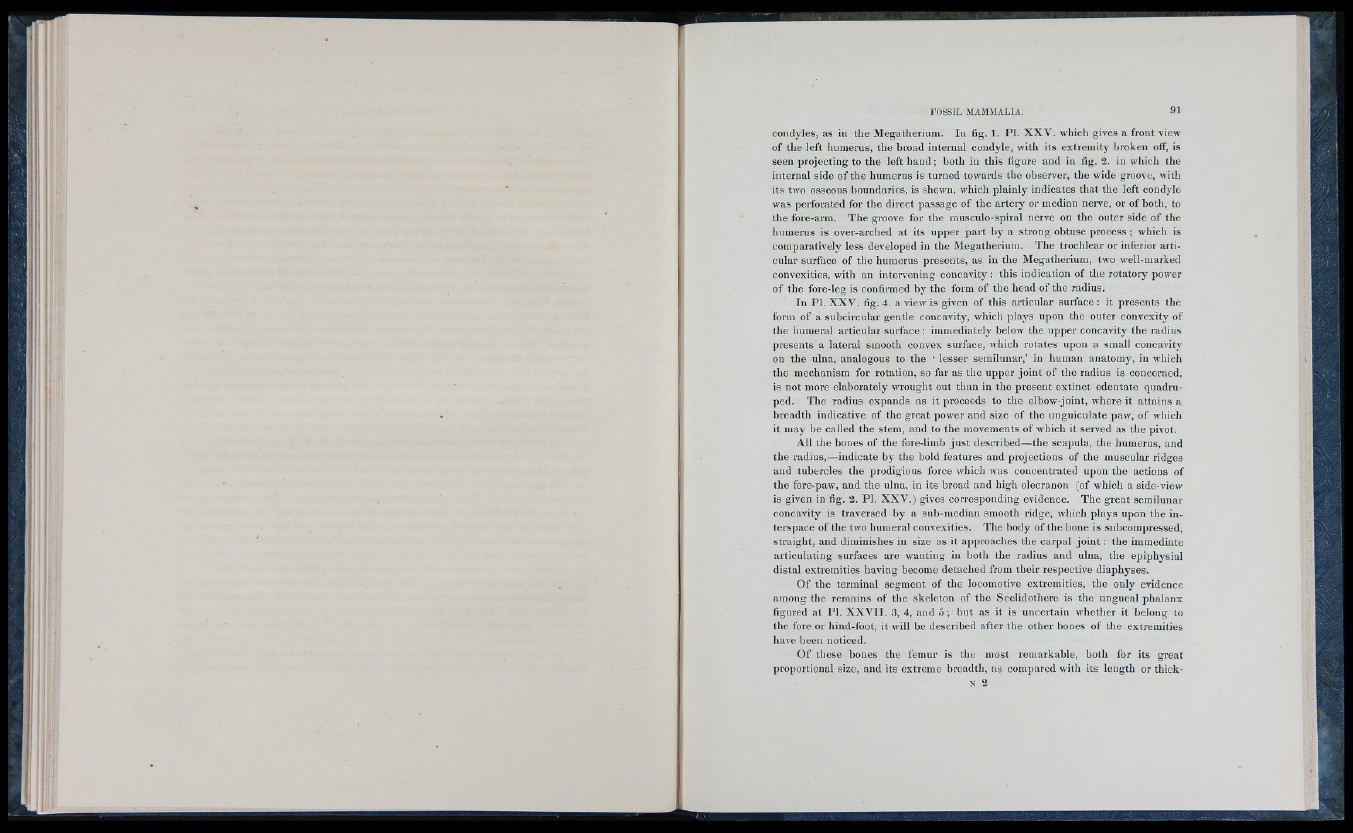
condyles, as in the Megatherium. In fig. I. PI. X X V . which gives a front view
o f the le ft humerus, the broad internal condyle, with its extremity broken off, is
seen projecting to the left hand; both in this figure and in fig. 2 . in which the
internal side o f the humerus is turned towards the observer, the wide groove, with
its two osseous boundaries, is shewn, which plainly indicates that the le ft condyle
was perforated for the direct passage o f the artery or median nerve, or o f both, to
the fore-arm. The groove for the musculo-spiral nerve on the outer side o f the
humerus is over-arched at its upper part h y a strong obtuse p r o c e ss ; which is
comparatively le ss developed in the Megatherium. The trochlear or inferior articular
surface o f the humerus presents, as in the Megatherium, two well-marked
convexities, with an intervening co n ca v ity : this indication o f the rotatory power
o f the fore-leg is confirmed by the form o f the head o f the radius.
In PI. X X V . fig. 4, a view is given o f this articular surface : it presents the
form o f a subcircular gentle concavity, which p lays upon the outer convexity o f
the humeral articular su r fa c e : immediately below the upper concavity the radius
presents a lateral smooth convex surface, which rotates upon a small concavity
on the ulna, analogous to the ‘ le sser semilunar,’ in human anatomy, in which
the mechanism for rotation, so far as the upper jo int o f the radius is concerned,
is not more elaborately wrought out than in the present ex tinc t edentate quadruped.
The radius expands as it proceeds to the elbow-joint, where it attains a
breadth indicative o f the great power and siz e o f the unguiculate paw, o f which
it may be called the stem, and to the movements o f which it served as the pivot.
A ll the bones o f the fore-limb ju st described—the scapula, the humerus, and
the radius,—indicate by the bold features and projections o f the muscular ridges
and tubercles the prodigious force which was concentrated upon the actions of
the fore-paw, and the ulna, in its broad and high olecranon (of which a side-view
is given in fig. 2 . PI. X X V .) gives corresponding evidence. The great semilunar
concavity is traversed by a sub-median smooth ridge, which plays upon the in terspace
o f the two humeral convexities. The body o f the bone is subcompressed,
straight, and diminishes in size as it approaches the carpal jo in t: the immediate
articulating surfaces are wanting in both the radius and ulna, the epiphysial
distal extremities having become detached from their respective diaphyses.
O f the terminal segment o f the locomotive extremities, the only evidence
among the remains o f the skeleton o f the Scelidothere is the ungueal phalanx
figured at PL X X V I I. 3, 4, and 5 ; but as it is uncertain whether it belong to
the fore or hind-foot, it will be described after the other bones o f the extremities
have been noticed.
O f these bones the femur is the most remarkable, both for its great
proportional size, and its extreme breadth, as compared with its length or thick-
N 2